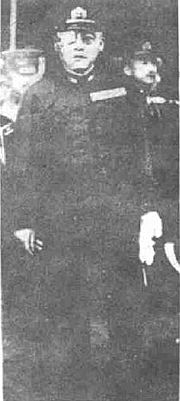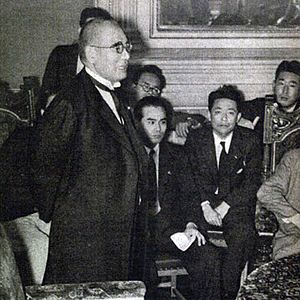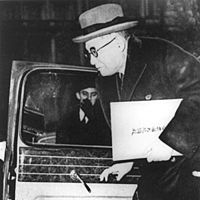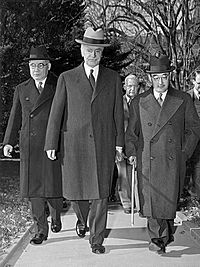Kichisaburō Nomura facts for kids
Quick facts for kids
Kichisaburō Nomura
|
|
|---|---|
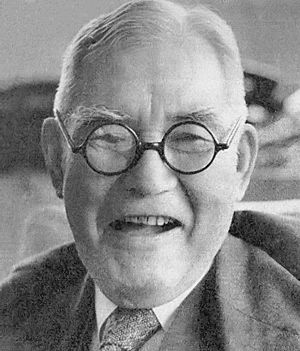 |
|
| Native name |
野村 吉三郎
|
| Born | December 16, 1877 Wakayama, Wakayama, Japan |
| Died | May 8, 1964 (aged 86) Shinjuku, Tokyo, Japan |
| Allegiance | |
| Service/ |
|
| Years of service | 1898–1937 |
| Rank | |
| Commands held |
|
| Awards | Order of the Rising Sun |
| Other work |
|
| Signature | |
Kichisaburō Nomura (野村 吉三郎, Nomura Kichisaburō, December 16, 1877 – May 8, 1964) was a very important person in Japan's history. He was a top admiral in the Imperial Japanese Navy. He also served as Japan's ambassador to the United States. He was the ambassador when the attack on Pearl Harbor happened.
Contents
Kichisaburō Nomura was born in Wakayama city, Japan. He joined the Imperial Japanese Naval Academy in 1898. He was a very good student, graduating as the second best in his class.
As a young officer, he sailed on ships like the Hiei and the battleship Yashima. He became an ensign in 1900. From 1901 to 1902, he traveled to the United States on the battleship Mikasa.
Nomura became a lieutenant in 1903. He served on many ships, including the Maya and Tokiwa. During the Russo-Japanese War, he was the chief navigator on the cruisers Saien and Takachiho.
After the war, he continued as a chief navigator. In 1908, he became a naval attaché in Austria. This means he was a naval officer working in an embassy. He was promoted to lieutenant commander. In 1910, he became a naval attaché in Germany.
He returned to Japan in 1911. He then became an executive officer on the cruiser Otowa. In 1913, he was promoted to commander.
World War I and Peace Conferences
During World War I, Nomura served as a naval attaché in the United States. He was there from 1914 to 1918. While in the U.S., he was promoted to captain in 1917.
When he came back to Japan, he commanded the cruiser Yakumo. Soon after, he joined Japan's team for the Versailles Peace Treaty Conference. This meeting helped end World War I.
After that, he went back to Washington, DC. There, he took part in the Washington Naval Conference from 1921 to 1922. This conference was about limiting naval weapons.
Becoming an Admiral
On June 1, 1922, Nomura was promoted to rear admiral. He held several important positions in the Navy. He was the chief of a section in the Navy General Staff. He also commanded the 1st Expeditionary Fleet.
He became a vice admiral in 1926. Later, he was the Commander in Chief of the Kure Naval District and the Yokosuka Naval District. These were very important naval bases in Japan.
The Shanghai Incident
In 1932, during the First Shanghai Incident, Nomura was the commander of the Third Fleet. His fleet supported the Japanese Army in Shanghai, China.
In April 1932, a bomb exploded at a celebration in Shanghai. Nomura and other Japanese officials were there. A Korean man named Yun Bong-gil threw the bomb. Nomura was seriously injured and lost sight in one eye. Other officials were also hurt, and one died.
Nomura was promoted to full admiral on March 1, 1933. From 1933 to 1937, he was a Naval Councilor. This was a high-level advisory role. He retired from active naval service in 1937.
Life as a Diplomat
After retiring from the Navy, Nomura became the principal of the Gakushūin Peer's school. This was a famous school in Japan. He held this role from 1937 to 1939.
From 1939 to 1940, he served as the Foreign Minister of Japan. This meant he was in charge of Japan's relationships with other countries.
Ambassador to the United States
On November 27, 1940, Nomura was sent to the United States as Japan's ambassador. President Roosevelt, who knew Nomura from his earlier time in Washington, welcomed him. Roosevelt saw Nomura as an honest man.
Throughout 1941, Nomura worked hard to prevent war between Japan and the United States. He talked with United States Secretary of State Cordell Hull. They discussed many issues. These included Japan's conflict with China and the US oil embargo against Japan.
Nomura tried to convince his own government to make agreements with the Americans. However, his pleas were often rejected. On November 15, 1941, another special envoy, Saburō Kurusu, joined Nomura in Washington.
Nomura and the Japanese Foreign Office did not know about the secret plan to attack Pearl Harbor. They received a message from Japan to end negotiations with the U.S. This message meant war. It arrived on December 8, but the embassy staff were off for Sunday. Nomura said this delay made him unable to deliver the message before the attack happened.
In his writings, Secretary Hull said that Nomura truly tried to prevent the war. Hull knew that Nomura was being used by Tokyo to gain time. But Nomura, who understood and respected America, always hoped for peace.
Later Life and Public Service
Nomura returned to Japan on August 20, 1942. He continued to advise the government during World War II. In May 1945, he was appointed to the Privy Council. This was a group of advisors to the Emperor.
After the war, Nomura started new careers. He was well-liked and had many connections. American officials, like former US Ambassador Joseph Grew, often visited him. They believed he had an important role in Japan's new democracy.
He was asked by Prime Minister Shigeru Yoshida to join a committee. This committee studied how Japan could rebuild its military during the Cold War.
He also worked for JVC, the Victor Company of Japan. This company was owned by Konosuke Matsushita, who was from Nomura's hometown. Nomura helped JVC reconnect with RCA in the U.S.
In 1954, Nomura ran for the House of Councillors. This is the upper house of Japan's parliament. He won by a large number of votes. In the late 1950s, he was considered for the head of the Defense Agency. However, he turned down these offers. He believed that civilians should control the armed forces.
Nomura was re-elected to the House of Councillors in 1960. He passed away in 1964 while still serving in office.
Honors
- Grand Cordon of the Order of the Rising Sun – February 7, 1934
- Order of the Golden Kite, Second Class – April 29, 1934
- Grand Cordon of the Order of the Sacred Treasure – July 13, 1940
- Grand Cordon of the Order of the Paulownia Flowers – May 8, 1964 (given after his death)
- Navy Distinguished Service Medal – 1918 (United States)
See also
 In Spanish: Kichisaburō Nomura para niños
In Spanish: Kichisaburō Nomura para niños


